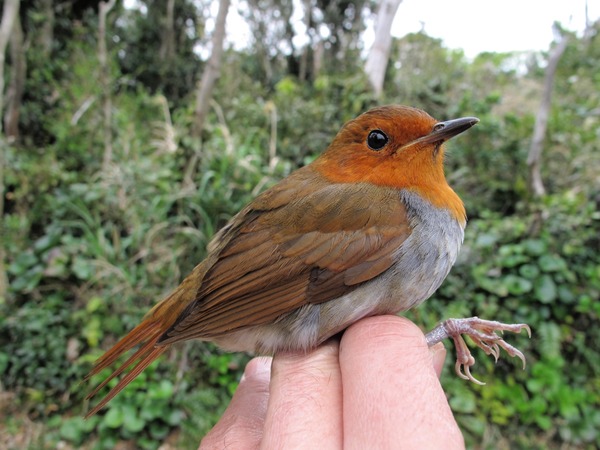 LINKED PAPER
LINKED PAPER
Genetic structure of the Japanese Robin Larvivora akahige endemic to East Asian islands. Seki, S.I. 2023 Ibis. doi: 10.1111/ibi.13197 VIEW
The Japanese Robin (Larvivora akahige) is largely a summer visitor to the montane or cool-temperate forests in the East Asian islands around Japan. The robin has a bright orange face and neck, resembling the breast colour of the European Robin (Erithacus rubecula) with both species being long classified in the genus Erithacus. The trilling song of the robin is very popular among birdwatchers. The robin is traditionally selected as one of the top three singing species of Japanese birds, together with the Blue-and-White Flycatcher (Cyanoptila cyanomelana) and Japanese Bush Warbler (Horornis diphone). It’s beautiful song is symbolic of the cool and comfortable highland climate during the hot and humid summer season of the Japanese Islands.

Figure 1 Sampling site on Rishiri Island, the northernmost region of the species range. Such a montane or cool-temperate forest with dense undergrowth is a typical habitat of the mainland subspecies.
The robin’s habitat includes a short chain of volcanic islands that branches off to the south from the middle of the major habitat chain. The population in the Izu Islands has been presumed to be a well-differentiated subspecies since its initial description, with unique phenotypical and ecological traits and geographically separated distributions (Ornithological Society of Japan 2012). However, results from robin mitochondrial DNA (mtDNA) analyses have caused confusion regarding the species’ traditional classification (Seki et al. 2012). Two distant mtDNA clades exist: one dominated throughout the species range, whereas the other coexisted only in the Izu Islands as a minor type. These two clades are thought to have diverged in two different refugia during the mid-Pleistocene glacial period, which preceded the formation of the volcanic Izu Islands (Seki et al. 2012). Such patterns of haplotype distribution indicate restricted gene flow among subspecies, although phenotypic traits may have differentiated independently from the mtDNA clade formation.

Figure 2 One of the former Japanese Robin breeding sites on Miyake Island, in the Izu Islands. The Izu Islands comprise a chain of active volcanic islands. The trees in the photographed area had died due to the damage caused by the eruption of the volcano in 2000, including volcanic debris and the following sulphur gas emission.

Figure 3 Male robin captured on Miyake Island. The Izu Islands’ robin is partially migratory and breeds in lowland warm-temperate forest. It is distinguished from the mainland subspecies by certain phenotypic characteristics, most notably by the lack of a black strip between the orange throat and greyish underpart in males (see also illustrations in Fig.4).
In my latest study published in IBIS, I examined the nuclear genetic structure of the Japanese Robin and revealed a distinct differentiation in microsatellite allelic frequency between the robins from the Izu Islands and those from mainland Japan, which is consistent with the subspecies boundary based on phenotypic traits. An important factor for this phenomenon may be the islands’ isolation from the mainland, although even on the mainland this species has locally isolated habitats, as it prefers montane or cool-temperate forests, thereby limiting its distribution to island-like patches. Differences in migratory habits between the subspecies may have promoted genetic differentiation beyond the simple effect of isolation-by-distance.

Figure 4 Mitochondrial DNA clade discrimination and ancestry probabilities for two nuclear clusters of each individual are overlaid on the distribution map of two robin subspecies.
In this study, the geographic distributions of the two distant mtDNA clades were also re-examined for numerous individuals from a larger region covering most of the species’ range. Accordingly, the major clade was found throughout the robin’s range, whereas the minor clade was restricted to the Izu Islands but persisted on all the sampled islands as a minor type. Although the origin of the minor clade and the mechanism underlying its present distribution remain unclear, one possible factor affecting its distribution may be natural selection acting on mitochondrial respiration efficiency, whereby the effect is strong in high-altitude montane habitats or during long-distance migration typical of mainland subspecies. The persistence of the minor clade, even on small islands, is another perplexing phenomenon that may be affected by the timing of the population contact or balancing selection in those islands. Further integrated research is required to reveal the species’ history and explain the present distribution pattern of the two mtDNA clades.
Despite its relatively limited isolation, given its proximity to the mainland, the Izu Islands are home to other endemic or near endemic birds other than the robin subspecies, such as the Izu Thrush (Turdus celaenops), Iijima’s Leaf Warbler (Phylloscopus ijimae), and two subspecies of the Varied Tit (Sittiparus varius). The geological, geographical, and environmental characteristics of the Izu Islands may have amplified the effects of physical isolation through differences in mainland selection pressures.
Sampling of the robin was similar to a tour exploring the entire wilderness of the Japanese Archipelago, covering major highlands as well as small, isolated islands. The northern part of the robin’s habitat is in Brown Bear (Ursus arctos) country, and sampling sites often coincided with areas of high bear density. Flights and sea voyages to the habitat islets were often delayed or cancelled because of bad weather caused by monsoons or early typhoons. I walked around the robin’s habitat, mostly alone, with a backpack storing all mist-netting and sampling tools. Thus, it took me over a decade to complete this work, but the observations I made during this sampling tour proved beneficial when I discussed the genetic results.
References
Ornithological Society of Japan. 2012. Check-list of Japanese Birds, 7th revised edition. Sanda: Ornithological Society of Japan.
Seki, S.-I., Nishiumi, I. & Saitoh, T. 2012. Distribution of two distinctive mitochondrial DNA lineages of the Japanese Robin Luscinia akahige across its breeding range around the Japanese islands. Zoological Science 29: 681-689. VIEW
Image credit
Top right: Japanese Robin Larvivora akahige © Shin-Ichi Seki.
If you want to write about your research in #theBOUblog, then please see here.




